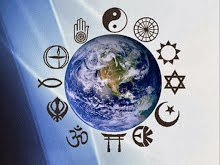The oldest known document in the world is the Rgveda, which is otherwise known simply as the Vedas (plural because it is split into four parts). It was orally passed down until around 5 BC, when writing either started or became more commonplace in India. It came from the Vedic people, who lived between the Ganga and Sindhu rivers.Some of the hymns, which deal with cosmology, imply that the rishis were very familiar with geometry and the planning needed to construct complex objects.The Vedas are known as God word and the Veda samhita is composed of hymns praising all form of
knowledge.They don't make distinctions between secular and sacred knowledge (as we define them today) because secular knowledge was thought to be a tool to be used to discover sacred knowledge.These Vedic knowledge interpreted in multiple ways in multiple contexts (astronomical, spiritual, terrestrial etc). All the equations and formulas of mathematics ha been already given in Vedas in form of Mantras.A few examples I am going to show you-
PYTHAGOREAN THEOREM-
This theorem was given by a Greek mathematician Pythagoras but it is already mentioned in Sulba Sutra (8th century B.C)-


Many equations are written there in word form,suppose that you have done one simple mathematical operation like-2*2=4,now just write it in word form then it should be like two multiplied by two gives four.Its very hard to interpret because its an oral document,there are no symbols or operations -- only words.
This means that not only were ancient mathematicians poets as well, but more importantly the math they were working with had to be written to fit in verse. Most people consider it hard to do long division using symbols and well worked out methods. Imagine trying to complete this process with words and in poetry! And then, consider the difficulty of decoding your work 4000 years later!

RIG VEDA-
Geometry-
Geometry has been used and its concept has been written throughout the Rig Vedas. These may look like poetic lines but they are really admiring and logical.This has been in our ancient time people were having many small small tricks to get time information or many rules are there in our daily life which we follow as it has been told in our religion but indirectly it is useful for our body.
The following verse in the Rig Veda deals with the formation of the universe-
Who was the measurer prama? What was the model pratima? What were the building materials for things offered nidânam ãjyam? What is the circumference (of this universe) paridhih? What are the meters or harmonies behind the Universe chandah? What is the triangle (yoke) praugam which connects this universe to the source of driving force, the engine?
All these Sanskrit words (ie: prama) are geometrical terms which also occur later in the Sulbasutra (where they are also defined).
Chariots are described in great detail in many different verses in the Rig Veda and Yajur Veda. Dr. Kulkarni writes:
The proficiency in chariot building presupposes a good deal of knowledge of geometry... The fixing of spokes of odd or even numbers require knowledge of dividing the area of the circle into the desired numbers of small parts of equal area, by drawing diameters. This also presupposes the knowledge of dividing a given angle into equal parts.
The Rig Veda is full of references to words in rituals whose definitions we find in subsequent Brahmanas and in the Sulba Sutra to be pointing to geometrical figures. For example, three types of fire altars, garhapatya, ahavaniya and dakhshina are mentioned in the Rig Veda but defined in the Shatapatha Brâhmana as being square, circular and semi circular, respectively, and also having the same area. Considering that ritualistic fire altar designs were not changed over a period of time and that the shastras were recited for several millennia before being written down, the rishis must have had a method to calculate the square root of the number two and the value of pi, without which they would not be able to determine whether the three altars had the same area or not.
Further some concepts given in vedas are very useful in computer languages and this has been recently discovered that for Artificial intelligence(AI) Sanskrit language is very useful as this could be easily understand and operated by computers.


Error Correction & Detection Codes
The Rig Veda was recited using a special method of recitation which is akin to modern error correction and detection codes. This feature has allowed it to be passed on from generation to generation for many millennia without the introduction of errors.
The rishis had focused on developing methods of chanting which can detect any errors in chanting of a mantra, such as omitting a syllable or replacing one syllable by another. For each mantra, there are several different methods of chanting, each method capable of detecting one type of error. For illustration, consider one half of the famous gayatri mantra of the seer Vishvamitra.The standard method of recitation involving conjunction is called Samhita patha (given below)
Samhita Patha
tatsaviturvarenyam
bhargo
devasya
dhimahi
Separate all compound words into their constituents and number the words:
tat
savituh
varenyam
bhargah
devasya
dhimahi
1
2
3
4
5
6
In the kramapatha chant, use a text obtained by combining two neighboring words according the rules of sandhi, resulting in six words-
1+2, 2+3, 3+4, 4+5, 5+6, 6+6
First usage of Pi-
In the Rigveda, a formula to find the area of a circle is mentioned showing that the Rishis knew of pi, approximating it to be equal to 22/7. It was used in the formula for the area of a circle
area of a circle = pi*(AB/2)^2 where AB is the diameter of a circle.
REFERENCE:- All above contents have been taken from Hindupedia-{expect images}



1 comments:
sangat bagus blognya gan...
Post a Comment